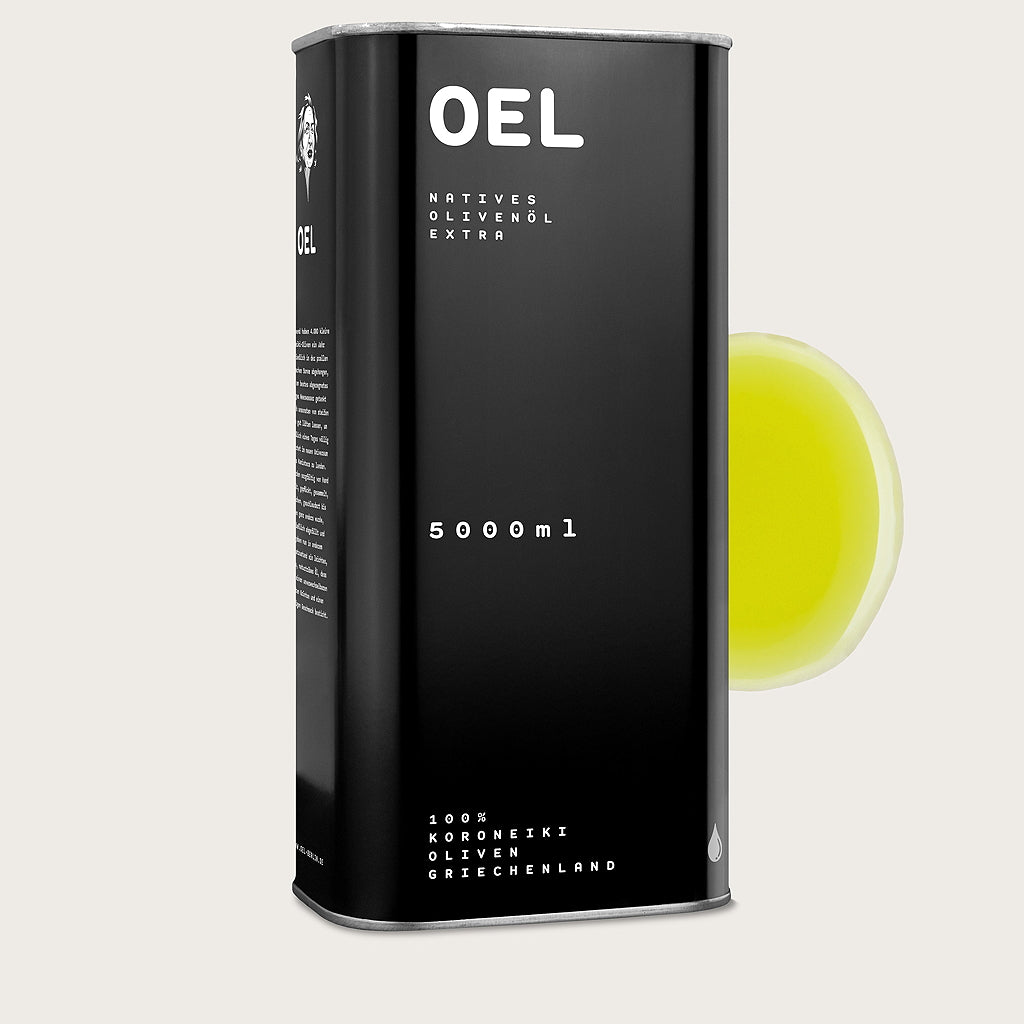

Multi-award-winning organic olive oil - harvested by hand
OEL 500 ml - mit Geschenkbanderole "Knorke" - Bio Natives Olivenöl Extra
Tax included. Shipping calculated at checkout
Hör mal was unser Öl so besonders macht:

0:00 / 0:00

0:00 / 0:00

➤ Geschenkedition mit Banderole: "Dit find ick knorke!" (Berlinerisch für "fabelhaft")
➤ Natives Olivenöl Extra aus Griechenland
➤ Bio-Anbau
➤ Sortenrein: 100 % Koroneiki Oliven
➤ Kalt extrahiert (< 27° C)
➤ Säuregehalt < 0,5%
➤ Geschmack nach frischem Gras, Nüssen und Zitrusfrüchten
➤ 1/2 Liter im recyclebaren Weißblechkanister (BPA non intent)
Ein hervorragendes Olivenöl erster Güteklasse.
Die Koroneiki Oliven für OEL stammen aus unserem eigenen Olivenhain in Andania sowie aus den Hainen von Ilias, der die hochmoderne Ölmühle von Andania betreibt. Alle Oliven für OEL werden in bäuerlicher Bio-Landwirtschaft angebaut und per Hand geerntet. Das schont Flora und Fauna.
Das Olivenöl wird in Ilias' Ölmühle kalt extrahiert und sofort unter Luftabschluss in Edelstahltanks gefüllt.
Die Banderole wird flach dazu geliefert. Sie hat einen komfortablen Klebestreifen zur Anbringung.

Excellent quality
Awarded twelve prizes at the most important olive oil competitions in the world.
Our history
frequently asked Questions
What makes olive oil from OEL so special?
The OEL brand stands for 100% pure Greek organic extra virgin olive oil:
The olives of the Koroneiki variety are grown organically near Kalamata in the Messinia region of the Peloponnese peninsula. The harvest is done by hand. We actively participate in harvesting and production every year because we want to be able to control and control the entire production chain ourselves.
The taste of the small green Koroneiki olive is legendary and its composition is unsurpassed. There is a reason why Koroneiki oil is the most popular olive oil in Greece.
But the geography and climate of the Messinia region also play a decisive role in the taste of OEL olive oil. The mountainous, extremely dry, stony region, which is very hot in summer, demands a lot of robustness and composure from the trees and the farmers. The result is an olive oil with flavors of citrus fruits and nuts.
Where does OEL olive oil come from?
The Koroneiki olives for OEL grow near Andania, a small village near Kalamata. Our state-of-the-art oil mill is also located here.
The region around Kalamata is considered the most important olive growing area in Greece. Olives have been cultivated here for thousands of years. In addition to the edible Kalamon (or Kalamata olive) used for oil production, the small green Koroneiki variety dominates here.
For good reason: The stony, hilly landscape, the hot summers and mild winters offer ideal conditions for the very aromatic, slightly bitter Koroneiki olives.
How does OEL taste?
The oil from the small green Koroneiki olives tastes very fresh, like grass, citrus fruits and nuts. The Koroneiki olive does not have as many bitter substances as some other olives.
By the way, the finish in olive oil is a sign of quality, caused by the polyphenols, antioxidant secondary plant substances.
What does “nativ extra” stand for?
Extra virgin olive oil is the highest quality category. Regarding its organoleptic properties, it has no defects; the taste is fruity. Its acidity must not exceed 0.8%.
The temperature of an extra virgin olive oil must not exceed 27 °C during production. This is important to protect the ingredients. Only under this condition can olive oil be called “cold-pressed” or “cold-extracted” and therefore “extra virgin”.
Other names: extra virgin, extra virgin
What is pure olive oil?
Single-variety means that only olives of one variety are used to produce oil - in our case the Koroneiki variety.
There are more than a thousand varieties of olives worldwide. And most olive oils on the market are blends, i.e. mixtures of oils from different types of olives, often unfortunately of different quality classes.
What does “Bird Safe” mean?
Our olives come exclusively from traditionally farmed areas
Groves in the Kalamata region that are harvested by hand during the day.
No bird or any other creature larger than a fingernail will be harmed here. We strictly reject industrial cultivation methods with fully automatic night-time harvesting, which can kill sleeping birds.
How does cold extraction work?
There are two methods to extract oil from the olive mash, i.e. to separate solid from liquid and oily from water: by pressing or by extraction using a centrifuge. This is where it is decided whether an olive oil is cold-pressed or cold-extracted during production.
The press presses the mash between mats and the centrifuge extracts the oil from the mash at several thousand revolutions per minute. The centrifuge is proven to be the gentlest method for processing olives after harvest. Our OEL is then immediately filled with UV and temperature insulation.
Why does OEL come in the canister?
We chose the tin canister as packaging for several reasons:
OEL is sealed in the canister in an airtight and opaque manner - two very important criteria for preserving the valuable ingredients.
Tinplate is very easy to recycle. Because it is magnetic, it can be easily fished out in sorting facilities and has one of the highest recycling rates of all packaging (91.1% in 2019, compared to glass 83.4%)
The canister has a very low weight and can be packed efficiently thanks to its square shape. This saves fuel on the long journey from Kalamata to Berlin.
Comparison of OEL, A! and olive oil from the supermarket
What makes OEL so special?
OEL Organic Extra Virgin Olive Oil is more expensive than olive oil from the supermarket. We'll show you why here:
OIL
A!
Supermarket olive oil
Yes
No
Yes No
Koroneiki
Koroneiki
Not known, mostly a blend
Native Extra
Native Extra
From extra virgin to sophisticated
From organic farmers in Andania
From farmers in Andania
Origin not traceable
Harvested by hand
Harvested with tools
Unknown
by 0.35%
by 0.5%
Unknown
Twelve times awarded at the most important olive oil competitions in the world












